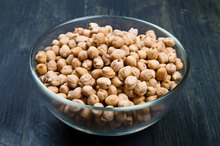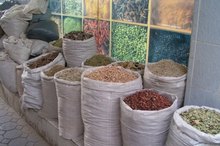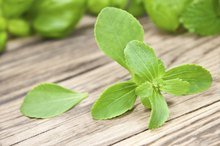What Causes Allergies to Cilantro?
Cilantro is a lacy-leafed herb used to season foods and is popular in Tex-Mex dishes in particular. Cilantro resembles parsley but has a much more pungent odor and taste. Its seeds are known as coriander, and they impart a different flavor than cilantro leaves and aren't used to season the same types of dishes. All parts of the cilantro plant are edible, and it is available all year long. An allergy to cilantro is rare but does happen, and you may have a higher likelihood of developing an allergy to cilantro if you are allergic to birch pollen.
Cilantro Allergy
An allergy to cilantro is classified as a food allergy. Eating a dish containing cilantro can trigger an immune reaction soon after ingesting it. Your immune system may mistake substances in cilantro as harmful and release antibodies, called IgE, or immunoglobulin E, that work to neutralize the perceived threat. Histamine is also released, which accounts for most of the symptoms of an allergic reaction. The medical journal "Allergy" reports that the substance that causes an allergic reaction to coriander, or cilantro seeds, is a type of protein.
- An allergy to cilantro is classified as a food allergy.
- The medical journal "Allergy" reports that the substance that causes an allergic reaction to coriander, or cilantro seeds, is a type of protein.
Oral Allergy Syndrome
Tamarind Spice Allergy
Learn More
Cilantro can also cause a type of allergy known as oral allergy syndrome, which is also called food-pollen allergy. It is caused by cross-reactivity between certain plant pollen proteins and some raw fruits, vegetables, nuts and spices. If you have an allergy to certain types of plant pollen, you may also experience a milder reaction to foods of related plant species. For example, if you are allergic to birch pollen, the Children's Hospital of Pennsylvania says that you may experience an oral allergy to some foods, including apples, peaches, cherries, plums, celery, potatoes, peppers, walnuts, almonds, fennel and coriander. Symptoms include tingling or swelling of the mouth and throat, and gum irritation. Oral allergy syndrome occurs because proteins in these foods are structurally similar to allergy-causing proteins in birch pollen and recognized by the body as allergens.
- Cilantro can also cause a type of allergy known as oral allergy syndrome, which is also called food-pollen allergy.
- Oral allergy syndrome occurs because proteins in these foods are structurally similar to allergy-causing proteins in birch pollen and recognized by the body as allergens.
Symptoms of a Cilantro Allergy
The symptoms of a cilantro allergy are basically the same as the symptoms for any food allergy. The reaction experienced can range from mild to life-threatening. MayoClinic.com states that most people develop allergic symptoms within a few minutes to two hours after eating the allergen food. Mild symptoms include tingling of the mouth and tongue, hives and itching. More severe symptoms include swelling of the mouth and lips, difficulty breathing and wheezing, abdominal pain, nausea, vomiting and light-headedness.
- The symptoms of a cilantro allergy are basically the same as the symptoms for any food allergy.
Anaphylactic Shock
Symptoms of Allergies to Chickpeas and Soy
Learn More
Although extremely rare, it's possible to have an anaphylactic reaction to coriander, or cilantro seeds. Anaphylactic shock is a life-threatening allergic reaction that requires immediate medical attention. This type of allergic reaction occurs immediately, causing all of the body tissues to release histamine. The symptoms of anaphylactic shock include swelling of the face, abdominal cramping, confusion, anxiety, difficulty breathing and swallowing, cough, drop in blood pressure, irregular heartbeat, rapid pulse, fainting, shock and loss of consciousness. This is a 911 emergency situation, and if not treated immediately, it can be fatal.
- Although extremely rare, it's possible to have an anaphylactic reaction to coriander, or cilantro seeds.
- Anaphylactic shock is a life-threatening allergic reaction that requires immediate medical attention.
Related Articles
References
- Food.com: Cilantro
- MayoClinic.com: Food Allergy; 2011
- PubMed: "Allergy to Coriander, A Case Report"; R. Suhonen et al; October 1979
- Children's Hospital of Pennsylvania; Oral Allergy Syndrome; 2003
- PubMed: "Coriander Anaphylaxis in a Spice Grinder with Undetected Occupational Allergy"; D.G. Ebo et al; May 2006
- Medline Plus: Anaphylaxis
- American College of Allergy, Asthma & Immunology. Oral allergy syndrome. March 21, 2019.
- American Academy of Allergy Asthma & Immunology. Oral allergy syndrome (OAS) or pollen fruit syndrome (PFS).
- Baumann L. Beware of natural fruit and nut ingredients in latex-allergic patients. August 16, 2019.
- NIAID-Sponsored Expert Panel: National Institute of Allergies and Infectious Diseases. “Guidelines for the Diagnosis and Management of Food Allergy in the United States: Report of the NIAID-Sponsored Expert Panel.” Journal of Allergy and Clinical Immunology.
- Singletary K. Coriander. Nutrition Today. 2016;51(3):151-161. doi:10.1097/nt.0000000000000159
- United States Department of Agriculture Agricultural Research Service. Coriander (cilantro) leaves, raw. Food Composition Databases.
- RxList. Coriander: Health Benefits, Uses, Side Effects, Dosage & Interactions.
- Eriksson1 N, Wu1 S, Do1 CB, et al. A genetic variant near olfactory receptor genes influences cilantro preference. Flavour.
- American Academy of Allergy, Asthma, and Immunology Can Spices Cause Allergic Reactions?
- Balasubramanian S, Roselin P, Singh KK, Zachariah J, Saxena SN. Postharvest Processing and Benefits of Black Pepper, Coriander, Cinnamon, Fenugreek, and Turmeric Spices. Crit Rev Food Sci Nutr. 2016;56(10):1585-607. DOI: 10.1080/10408398.2012.759901
- Natural Medicines Database. Coriander. Professional Monograph and Patient Handout. Published Dec. 2017.
- Singletary, K. (2016). Coriander. Nutrition Today, 51(3), 151–161. DOI: 10.1097/nt.0000000000000159
Writer Bio
Kathryn Meininger began writing and publishing poetry in 1967. She was co-founder and editor of the professional magazine "Footsteps" and began writing articles online in 2010. She earned a Doctor of Podiatric Medicine from Temple University School of Podiatric Medicine and a Bachelor of Arts in biology from William Paterson University.









